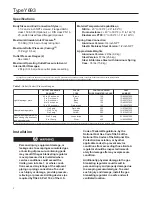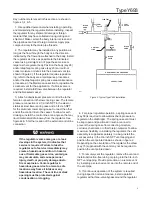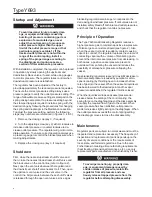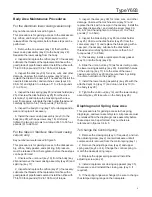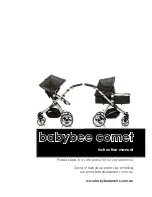
Type Y693
5
Body Area Maintenance Procedures
For the Aluminum lower casing version only:
Key numbers are referenced in figure 4.
This procedure is for gaining access to the disk assem-
bly, orifice, and body O-ring. All pressure must be
released from the regulator, before these steps can be
performed.
1. Remove the cap screws (key 18) that hold the
lower casing assembly (key 9) to the body (key 28).
Separate the lower casing from the body.
2. Inspect and replace the orifice (key 27) if necessary.
Lubricate the threads of the replacement orifice with a
good grade of pipe thread sealant. Install the orifice with
75 to 100 foot-pounds (102 to 136 N•m) of torque.
3. Inspect the disk (key 99) for nicks, cuts, and other
damage. Unscrew the machine screw (key 12) and
replace the disk with a new part if necessary. Install the
new disk, disk washer, and machine screw (keys 99,
98, & 12) and tighten to a torque of 1 to 2 foot-pounds
(1 to 3 N•m).
4. Inspect the bias spring (key 85) and disk holder (key
25). Unscrew the disk holder (key 25) from the valve
stem (key 13) and replace the bias spring with a new
part, if necessary. Lubricate the disk holder threads and
carefully tighten to 5 to 7 foot-pounds (7 to 9 N•m).
5. Inspect the body O-ring (key 16) for damage and/or
wear and replace if necessary.
6. Install the lower casing assembly (key 9) to the
body (key 28) with cap screws (key 18). Uniformly
tighten the two cap screws to a torque of 45 to 50 foot-
pounds (61 to 68 N•m).
For the Steel or Stainless Steel lower casing
version only:
Key numbers are referenced in figure 5.
This procedure is for gaining access to the disk assem-
bly, orifice, body gasket, and split ring. All pressure
must be released from the regulator, before these steps
can be performed.
1. Unscrew the union nut (key 19) from the body (key
28) and remove the lower casing assembly (key 20) and
split ring (key 17).
2. Inspect and replace the orifice (key 27) if necessary.
Lubricate the threads of the replacement orifice with a
good grade of pipe thread sealant. Install the orifice with
75 to 100 foot-pounds (102 to 136 N•m) of torque.
3. Inspect the disk (key 99) for nicks, cuts, and other
damage. Unscrew the machine screw (key 12) and
replace the disk with a new part if necessary. Install the
new disk, disk washer, and machine screw (keys 99,
98, & 12) and hand tighten to a torque of 1 to 2 foot-
pounds (1 to 3 N•m).
4. Inspect the bias spring (key 85) and disk holder
(key 25). Unscrew the disk holder (key 25) from the
valve stem (key 13) and replace the bias spring with a
new part, if necessary. Lubricate the disk holder
threads and carefully tighten to no more than 5 to 7
foot-pounds (7 to 9 N•m).
5. If necessary, install a replacement body gasket
(key 16) into the body (key 28).
6. Slide the union nut (key 19) as far as it will go onto
the lower casing assembly (key 20). Install both halves
of the split ring (key 17) into the slots of the lower
casing assembly (key 20) and secure them by sliding
the union nut down on the split ring.
7. Install the lower casing assembly (key 20) with the
attached split ring (key 17) and union nut (key 19) to
the body (key 28).
8. Tighten the union nut (key 19) until the lower casing
assembly (key 20) is secure on the body (key 28).
Diaphragm and Spring Case Area
This procedure is for gaining access to the spring,
diaphragm, and lever assembly stem. All pressure must
be released from the diaphragm case assembly before
these steps can be performed. Key numbers are
referenced in figures 3, 4 & 5.
To Change the Control Spring:
1. Remove the closing cap (key 3, if required), and turn
the adjusting screw (key 2) counterclockwise until all
compression is removed from the control spring (key 1).
2. Remove the adjusting screw (key 2) and upper
spring seat (key 4 or 44). Change the control spring to
match the desired spring range.
3. Replace the upper spring seat and install the
adjusting screw (key 2).
4. Install a replacement closing cap gasket (key 35),
if necessary, and reinstall the closing cap (key 3, if
required).
5. If the spring range was changed, be sure to change
the stamped spring range on the nameplate.


